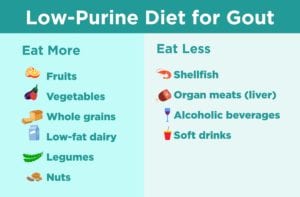Has your doctor suggested that you or someone you love go on a low-purine diet to help with the painful symptoms of gout? If so, it’s important to understand what a low-purine diet is, and how it may help manage gout as part of your overall gout treatment plan.
Gout is a type of arthritis that develops when high levels of a chemical called uric acid in the blood cause uric acid crystals to build up in a joint. This can lead to inflammation and pain, often in the big toe, as well as other joints. Gout attacks, or flares, are often extremely and suddenly painful and debilitating.
In most people, the body produces a manageable amount of uric acid, and the kidneys eliminate any excess through the urine. In a person with gout, however, the body doesn’t have good control over the amount of uric acid in the blood. “The goal of gout treatment is to lower the level of uric acid back to normal so it won’t cause problems,” says Calvin R. Brown, Jr., MD, professor of medicine at the Feinberg School of Medicine of Northwestern University in Chicago. Depending on your specific needs, a combination of medication to manage gout and lifestyle changes, including a low-purine diet, can help you reach that target.
It’s very important to get uric acid levels to a healthy level and keep them there. Without proper treatment, gout flares can become more frequent, affect more joints, and lead to bone and joint damage as well as these other significant gout complications.
What Are Purines?
Purines are substances that are present in all living things, including our bodies. They are also found in varying levels in the foods we eat. When your body breaks down purines, they form uric acid. For a person with gout, this can cause problems. “If you eat a lot of purines, your body will end up making a lot of uric acid,” says Dr. Brown.
For many people with gout, diet changes (such as reducing purines) alone are unlikely to be a single solution. Uric acid from food only makes up about 15 percent of the uric acid in your body, which makes medication a crucial piece of treatment for gout.
Dietary changes, however, can also be a valuable part of your gout treatment plan. In one study from Boston University of more than 600 people with gout, those who ate a high-purine diet were about five times as likely to have an attack compared with people who ate the lowest-purine diets .
Purines are found in high levels in foods like shellfish, organ meats, high-fructose corn syrup-sweetened soft drinks, and alcoholic beverages.
What a Low-Purine Diet for Gout Looks Like
While there are foods that can increase uric acid levels, you can also eat in a way that has the opposite effect and helps reduce purines and uric acid levels. The DASH diet (Dietary Approaches to Stop Hypertension) is of great interest to gout researchers at the moment.
“The diet was originally developed to lower blood pressure, but it also seems to lower the risk of gout,” says Dr. Brown. People with gout who followed the DASH diet for 30 days lowered their uric acid levels by .35 mg/dL on average, according to a 2016 study published in the journal Arthritis & Rheumatology. Those who started with the highest levels of uric acid saw the greatest declines.
The DASH diet focuses on fruits, vegetables, whole grains, and low-fat dairy products along with some fish, poultry, legumes, and nuts. It’s also low in red and processed meats and sugary drinks, which are high-purine foods that people with gout are recommended to keep to a minimum. The DASH diet is similar to the Mediterranean diet.
Research also shows that eating low-fat dairy such as yogurt, cheese, and milk may lower uric acid in the blood and decrease inflammation caused by uric acid crystals.
Low-purine foods that may help reduce uric acid in the body include fruits, vegetables, whole grains, legumes, nuts, and low-fat dairy.
Weight Loss for Managing Gout
Another recommendation often given to people with gout is to lose weight if needed. Studies show that weight loss can help lower uric acid levels and possibly prevent attacks. However, there is a need for more rigorous studies in this area, say researchers.
Low-Purine Diet Sample Menu and Eating Plan
If you have gout and you’re not sure what to eat, here’s a sample three-day plan of a low-purine diet to help you get started.
Day 1
- Breakfast: Oatmeal + sliced peach + almond butter
- Lunch: Greek yogurt + chopped tomato and cucumber salad + whole wheat pita bread
- Dinner: Spinach and feta cheese omelet + whole grain toast + mashed avocado
Day 2
- Breakfast: Cottage cheese + melon + bran cereal flakes
- Lunch: Egg salad sandwich on whole wheat bread + lettuce + tomato
- Dinner: Whole wheat pasta + cannellini beans + broccoli + garlic + sprinkle of parmesan cheese
Day 3
- Breakfast: Whole grain cereal + low-fat milk + sliced strawberries
- Lunch: Black bean soup garnished with chopped tomato and scallions + tortilla chips
- Dinner: Veggie burger + whole wheat bun + roasted sweet potato wedges






